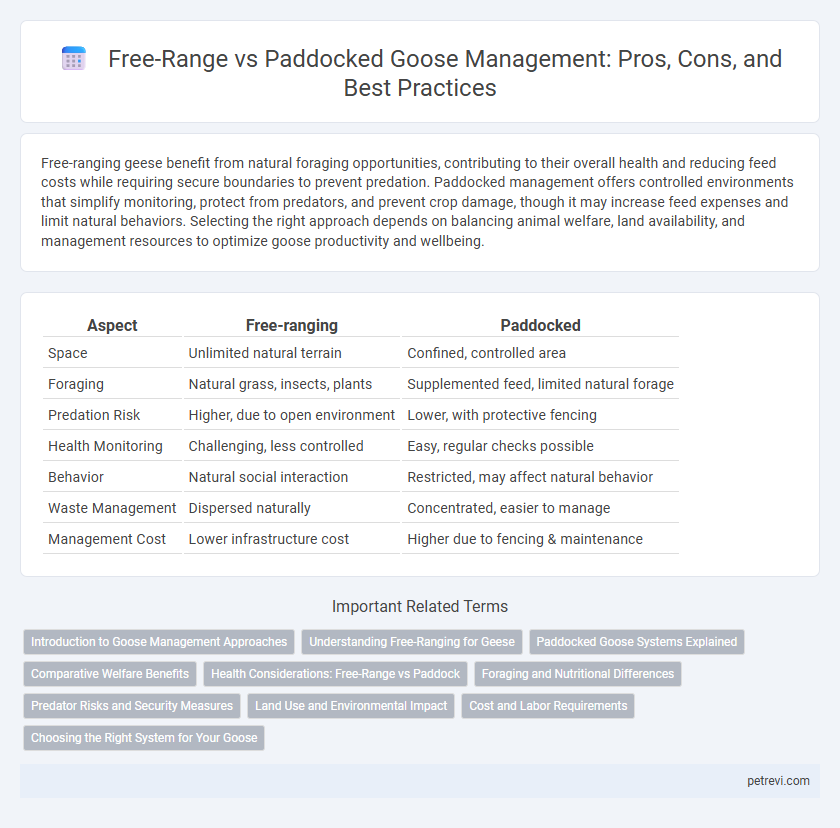Free-ranging geese benefit from natural foraging opportunities, contributing to their overall health and reducing feed costs while requiring secure boundaries to prevent predation. Paddocked management offers controlled environments that simplify monitoring, protect from predators, and prevent crop damage, though it may increase feed expenses and limit natural behaviors. Selecting the right approach depends on balancing animal welfare, land availability, and management resources to optimize goose productivity and wellbeing.
Table of Comparison
| Aspect | Free-ranging | Paddocked |
|---|---|---|
| Space | Unlimited natural terrain | Confined, controlled area |
| Foraging | Natural grass, insects, plants | Supplemented feed, limited natural forage |
| Predation Risk | Higher, due to open environment | Lower, with protective fencing |
| Health Monitoring | Challenging, less controlled | Easy, regular checks possible |
| Behavior | Natural social interaction | Restricted, may affect natural behavior |
| Waste Management | Dispersed naturally | Concentrated, easier to manage |
| Management Cost | Lower infrastructure cost | Higher due to fencing & maintenance |
Introduction to Goose Management Approaches
Goose management involves distinct approaches, primarily free-ranging and paddocked systems, each affecting bird behavior, health, and productivity. Free-ranging geese forage over large areas, promoting natural grazing patterns and reducing feed costs, while paddocked systems confine geese to controlled spaces, enhancing monitoring and protection from predators. Selecting between free-ranging and paddocked methods depends on farm size, resource availability, and desired management intensity.
Understanding Free-Ranging for Geese
Free-ranging geese have unrestricted access to open pastures, allowing natural foraging behaviors that enhance diet variety and overall health. This method promotes stronger immunity and reduces feed costs by enabling geese to graze on grasses, insects, and aquatic plants found in their environment. Managing free-ranging geese requires adequate predator control and access to fresh water sources to maintain welfare and optimal growth.
Paddocked Goose Systems Explained
Paddocked goose systems involve confining geese within fenced enclosures that allow controlled grazing while protecting crops and preventing over-foraging. These systems optimize pasture utilization by rotating paddocks, enhancing soil health, and reducing parasite build-up compared to free-ranging methods. Paddocked management improves biosecurity and enables efficient monitoring of geese behavior, welfare, and growth performance.
Comparative Welfare Benefits
Free-ranging geese display enhanced natural behaviors like foraging and social interaction, contributing to improved physical health and reduced stress levels compared to paddocked systems. Paddocked management offers controlled environments that can minimize predation risks and facilitate easier health monitoring but may limit movement and natural behavioral expression. Balancing outdoor access with protective measures optimizes welfare outcomes by combining natural habitat stimulation with safety.
Health Considerations: Free-Range vs Paddock
Free-ranging geese benefit from natural foraging, which enhances their immune system and reduces parasitic infections compared to confined paddocked environments. Paddocked geese face higher risks of disease transmission due to limited space and increased fecal contamination, necessitating rigorous sanitation measures. Managing health in either system requires balancing exposure to natural behaviors with the mitigation of environmental health risks.
Foraging and Nutritional Differences
Free-ranging geese have access to diverse natural forage, including grasses, clover, and aquatic plants, which enhances nutrient intake and promotes natural foraging behavior. Paddocked geese rely primarily on provided feed, which may lack the variety of nutrients found in natural vegetation, potentially affecting foraging instincts and overall health. Nutritional differences influence growth rates, digestive efficiency, and immune function, highlighting the importance of forage diversity in goose management.
Predator Risks and Security Measures
Free-ranging geese face higher predator risks including foxes, raccoons, and birds of prey, requiring natural barriers and vigilant monitoring to enhance security. Paddocked geese benefit from controlled environments equipped with secure fencing, overhead netting, and motion-activated lighting that significantly reduce the threat of predator attacks. Effective predator management combines physical barriers, regular security checks, and strategic placement of paddocks to ensure optimal protection for goose populations.
Land Use and Environmental Impact
Free-ranging geese require extensive land areas, promoting natural foraging but potentially leading to overgrazing and soil compaction, which impacts local vegetation and water quality. Paddocked systems concentrate geese in controlled sections, reducing overall land use and allowing for targeted pasture management, but risk nutrient buildup and localized environmental degradation if not properly rotated. Effective goose management balances land availability with environmental impacts, optimizing grazing patterns to sustain ecosystem health and productivity.
Cost and Labor Requirements
Free-ranging goose management typically incurs lower feed costs but demands increased labor for monitoring and protection against predators, making it suitable for larger acreage with fewer hands-on interventions. Paddocked systems require higher initial investment in fencing and infrastructure, alongside more frequent labor for maintenance and goose handling, but provide controlled environments that enhance pasture utilization and biosecurity. Evaluating the balance between labor availability and budget constraints is crucial for selecting the optimal management approach for efficient goose production.
Choosing the Right System for Your Goose
Free-ranging geese benefit from natural foraging, resulting in improved health and reduced feed costs, but require ample space and effective predator control. Paddocked systems offer easier management, protection, and controlled grazing, making them ideal for small-scale or intensive operations. Selecting the right management system depends on your land availability, flock size, and overall production goals to optimize welfare and productivity.
Free-ranging vs Paddocked for Goose Management Infographic

 petrevi.com
petrevi.com